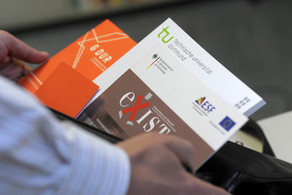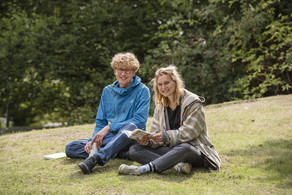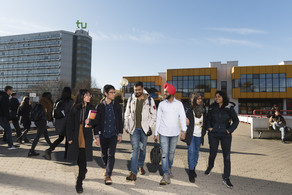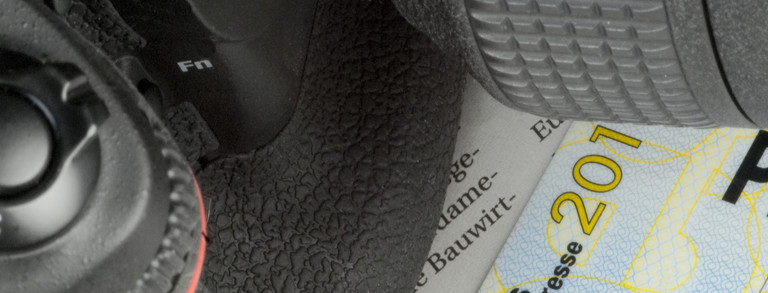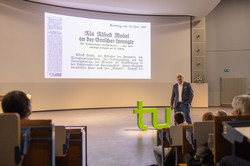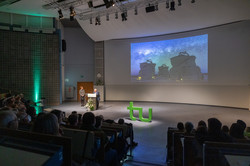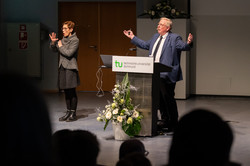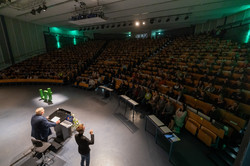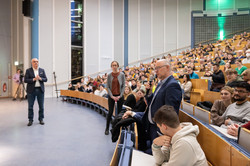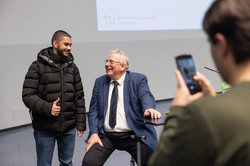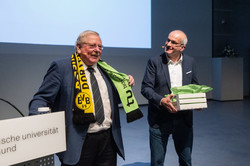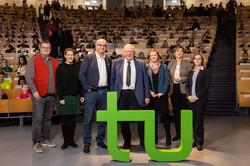Nobel Prize Laureate Talks about Black Hole at the Center of Our Milky Way
- Top News
- Campus & Culture
- People
- Press Releases
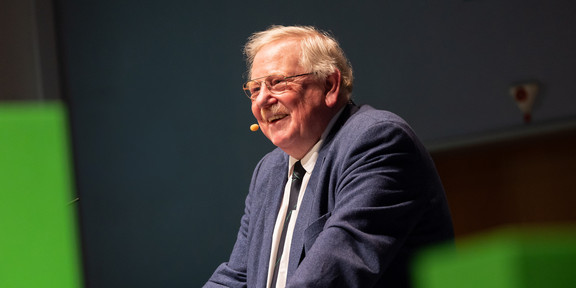
In 2020, Prof. Reinhard Genzel, Director at the Max Planck Institute for Extraterrestrial Physics in Garching near Munich, was awarded the Nobel Prize in Physics. On Wednesday, 29 November, he shared his story of how he succeeded in proving that there is a black hole at the center of our Milky Way. About 1,000 guests had come to the fully packed main lecture hall and an additional lecture hall at TU Dortmund University to listen to his presentation. The lecture was part of the “Initial Spark” series, which commemorates that Alfred Nobel once conducted experiments at the neighboring Dorstfeld coal mine.
Whether in science fiction movies, pop culture or science: black holes exert quite a strong attractive force. Reinhard Genzel is one of the world’s leading researchers in astrophysics, specializing in black holes and the formation of galaxies. Under the title “Galaxies & Black Holes – A Forty-Year Journey”, he took the audience on an expedition through his life’s work as an astrophysicist – from the discovery of a dense mass in the center of our Milky Way to the Nobel Prize for his research on the very object known as Sagittarius A*, which he was able to identify beyond any doubt as a black hole.
This journey, which Genzel described during the “Initial Spark” lecture, began in 1985 at the University of California in Berkeley. Together with other researchers, Prof. Genzel discovered a massive object in the center of our galaxy. The scientists suspected it was a black hole and published their theory in the scientific journal Nature. However, instead of recognition, the group was met with many doubts: “Nobody believed us,” said Genzel. There was a lack of clear evidence and no shortage of alternative explanations.
Perseverance and a willingness to take risks: “Nothing comes from nothing.”
Nevertheless, Reinhard Genzel refused to be abandon research on his discovery. “You have to make an effort, because nothing comes from nothing,” he commented in the main lecture hall. “Research requires experimentation, patience and the chance to carry it out at all. The Max Planck Society gave us the resources to do research and allowed us to go on an adventurous journey with an uncertain outcome.” The willingness to take risks and perseverance were rewarded: over time, new telescopes allowed to observe increasingly precise measurements of stellar movements around the center of our Milky Way. For example, the Very Large Telescope, the world’s largest observatory run by the European Southern Observatory in Chile, enabled scientists to obtain increasingly detailed images from space at the turn of the millennium. These images made it possible to better analyze the dense mass in the center of our galaxy and to determine its mass to be over 4 million solar masses.
By using images from telescopes of this kind, the evidence that there is indeed a black hole at the center of our galaxy was consolidated. At the same time, the new data enabled Genzel and his team to rule out more and more alternative explanations for the condensed mass. In 2020, after around four decades of intensive research, Prof. Genzel was awarded the Nobel Prize in Physics alongside Roger Penrose and Andrea Ghez.
During his lecture in the main lecture hall, the astrophysicist accompanied the report on his journey to the Nobel Prize with thought experiments, humorous anecdotes and videos with musical accompaniment - from a ballet of stars to “Highway to Hell” by AC/DC. After the lecture, Genzel answered a number of subject-specific as well as many philosophical questions from the audience. He also spent a long time taking photos with interested guests and signing autographs after the end of his lecture.
About the “Initial Spark” series
The Swedish chemist Alfred Nobel, inventor of dynamite and founder of the Nobel Prize, experimented with explosives for mining in Dortmund-Dorstfeld at the local Dorstfeld coal mine in the 1860s, among other places. In order to detonate nitroglycerine with greater safety, he developed the method of an initial spark in 1863, referred to as “Initialzündung” in German. In reference to this experimental phase of Nobel’s work in Dortmund, the lecture series is entitled “Initial Spark”. The program is supported by the Wilo-Foundation. So far, Prof. Frances Arnold (Nobel Prize in Chemistry 2018), Prof. Erwin Neher (Nobel Prize in Medicine 1991), Prof. Benjamin List (Nobel Prize in Chemistry 2021) and Prof. Reinhard Genzel (Nobel Prize in Physics 2020) have held guest lectures at TU Dortmund University.


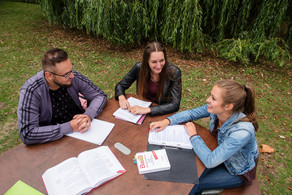
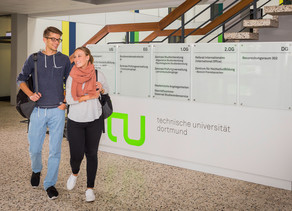
![[Translate to English:] Partner Four hands are holding the green logo of TU Dortmund University](/storages/tu_website/_processed_/1/d/csm_Partner_Nicole_Rechmann_KW_40b35bb3fd.jpg)

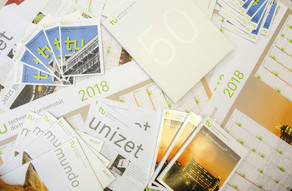
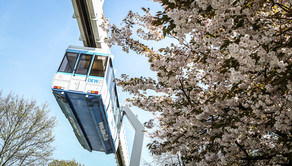
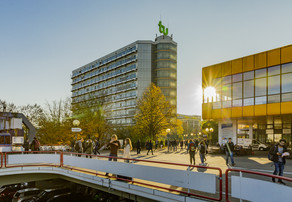
![[Translate to English:] Forschung An apparatus with tubes in a laboratory](/storages/tu_website/_processed_/0/c/csm_Forschung_Juergen_Huhn_cbd34afd6d.jpg)
![[Translate to English:] Studium Five students are sitting in a lecture hall. They are talking to each other.](/storages/tu_website/_processed_/c/9/csm_Studium_FelixSchmale_81d94adc86.jpg)
